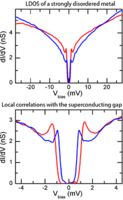当前位置:
X-MOL 学术
›
Phys. Rev. B
›
论文详情
Our official English website, www.x-mol.net, welcomes your feedback! (Note: you will need to create a separate account there.)
Spectroscopic evidence for strong correlations between local superconducting gap and local Altshuler-Aronov density of states suppression in ultrathin NbN films
Physical Review B ( IF 3.7 ) Pub Date : 2020-07-02 , DOI: 10.1103/physrevb.102.024504 C. Carbillet , V. Cherkez , M. A. Skvortsov , M. V. Feigel'man , F. Debontridder , L. B. Ioffe , V. S. Stolyarov , K. Ilin , M. Siegel , C. Noûs , D. Roditchev , T. Cren , C. Brun
Physical Review B ( IF 3.7 ) Pub Date : 2020-07-02 , DOI: 10.1103/physrevb.102.024504 C. Carbillet , V. Cherkez , M. A. Skvortsov , M. V. Feigel'man , F. Debontridder , L. B. Ioffe , V. S. Stolyarov , K. Ilin , M. Siegel , C. Noûs , D. Roditchev , T. Cren , C. Brun

|
Disorder has different profound effects on superconducting thin films. For a large variety of materials, increasing disorder reduces electronic screening which enhances electron-electron repulsion. These fermionic effects lead to a mechanism described by Finkelstein: when disorder combined to electron-electron interactions increases, there is a global decrease of the superconducting energy gap and of the critical temperature , the ratio / remaining roughly constant. In addition, in most films, an emergent granularity develops with increasing disorder and results in the formation of inhomogeneous superconducting puddles. These gap inhomogeneities are usually accompanied by the development of bosonic features: a pseudogap develops above the critical temperature and the energy gap starts decoupling from . Thus the mechanism(s) driving the appearance of these gap inhomogeneities could result from a complicated interplay between fermionic and bosonic effects. By studying the local electronic properties of an NbN film with scanning tunneling spectroscopy (STS), we show that the inhomogeneous spatial distribution of is locally strongly correlated to a large depletion in the local density of states (LDOS) around the Fermi level, associated to the Altshuler-Aronov effect induced by strong electronic interactions. By modeling quantitatively the measured LDOS suppression, we show that the latter can be interpreted as local variations of the film resistivity. This local change in resistivity leads to a local variation of through a local Finkelstein mechanism. Our analysis furnishes a purely fermionic scenario explaining quantitatively the emergent superconducting inhomogeneities, while the precise origin of the latter remained unclear up to now.
中文翻译:

超薄NbN薄膜中局部超导间隙与局部状态抑制的Altshuler-Aronov密度之间强相关性的光谱证据
混乱对超导薄膜具有不同的深远影响。对于各种各样的材料,增加的无序性会降低电子屏蔽,从而增强电子-电子排斥力。这些费米离子效应导致了Finkelstein描述的机制:当与电子-电子相互作用结合的无序增加时,超导能隙整体减小 和临界温度 , 比例 /保持大致恒定。另外,在大多数电影中,出现的颗粒随着紊乱的增加而发展,并导致形成不均匀的超导水坑。这些间隙不均匀性通常伴随着玻色特征的发展:在临界温度以上会产生假间隙 和能隙 从开始解耦 。因此,驱动这些间隙不均匀性出现的机制可能是由于铁离子效应和玻色子效应之间复杂的相互作用所致。通过使用扫描隧道光谱(STS)研究NbN薄膜的局部电子特性,我们显示出NbN薄膜的不均匀空间分布费米能级附近的局部态密度(LDOS)的大量消耗与强度的强烈降低相关,这与强电子相互作用引起的阿尔茨勒-阿罗诺夫效应有关。通过对测得的LDOS抑制进行定量建模,我们表明后者可以解释为薄膜电阻率的局部变化。电阻率的这种局部变化导致通过当地的Finkelstein机制。我们的分析提供了一个纯费米子态的场景,定量地解释了出现的超导不均匀性,而到目前为止,后者的确切来源仍不清楚。
更新日期:2020-07-02
中文翻译:

超薄NbN薄膜中局部超导间隙与局部状态抑制的Altshuler-Aronov密度之间强相关性的光谱证据
混乱对超导薄膜具有不同的深远影响。对于各种各样的材料,增加的无序性会降低电子屏蔽,从而增强电子-电子排斥力。这些费米离子效应导致了Finkelstein描述的机制:当与电子-电子相互作用结合的无序增加时,超导能隙整体减小 和临界温度 , 比例 /保持大致恒定。另外,在大多数电影中,出现的颗粒随着紊乱的增加而发展,并导致形成不均匀的超导水坑。这些间隙不均匀性通常伴随着玻色特征的发展:在临界温度以上会产生假间隙 和能隙 从开始解耦 。因此,驱动这些间隙不均匀性出现的机制可能是由于铁离子效应和玻色子效应之间复杂的相互作用所致。通过使用扫描隧道光谱(STS)研究NbN薄膜的局部电子特性,我们显示出NbN薄膜的不均匀空间分布费米能级附近的局部态密度(LDOS)的大量消耗与强度的强烈降低相关,这与强电子相互作用引起的阿尔茨勒-阿罗诺夫效应有关。通过对测得的LDOS抑制进行定量建模,我们表明后者可以解释为薄膜电阻率的局部变化。电阻率的这种局部变化导致通过当地的Finkelstein机制。我们的分析提供了一个纯费米子态的场景,定量地解释了出现的超导不均匀性,而到目前为止,后者的确切来源仍不清楚。



























 京公网安备 11010802027423号
京公网安备 11010802027423号